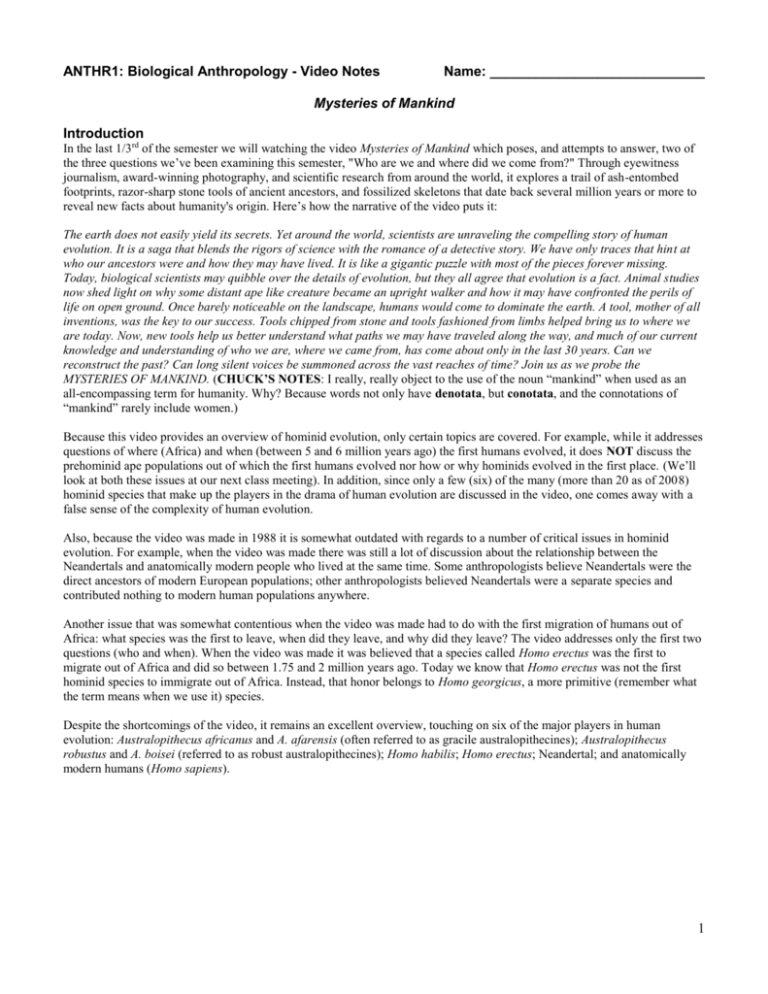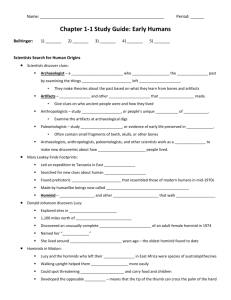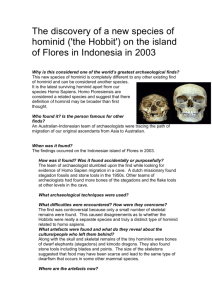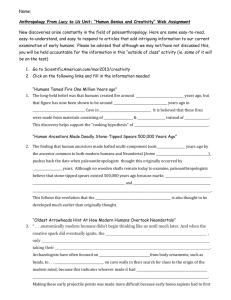Mysteries of Mankind
advertisement

ANTHR1: Biological Anthropology - Video Notes Name: ____________________________ Mysteries of Mankind Introduction In the last 1/3rd of the semester we will watching the video Mysteries of Mankind which poses, and attempts to answer, two of the three questions we’ve been examining this semester, "Who are we and where did we come from?" Through eyewitness journalism, award-winning photography, and scientific research from around the world, it explores a trail of ash-entombed footprints, razor-sharp stone tools of ancient ancestors, and fossilized skeletons that date back several million years or more to reveal new facts about humanity's origin. Here’s how the narrative of the video puts it: The earth does not easily yield its secrets. Yet around the world, scientists are unraveling the compelling story of human evolution. It is a saga that blends the rigors of science with the romance of a detective story. We have only traces that hint at who our ancestors were and how they may have lived. It is like a gigantic puzzle with most of the pieces forever missing. Today, biological scientists may quibble over the details of evolution, but they all agree that evolution is a fact. Animal studies now shed light on why some distant ape like creature became an upright walker and how it may have confronted the perils of life on open ground. Once barely noticeable on the landscape, humans would come to dominate the earth. A tool, mother of all inventions, was the key to our success. Tools chipped from stone and tools fashioned from limbs helped bring us to where we are today. Now, new tools help us better understand what paths we may have traveled along the way, and much of our current knowledge and understanding of who we are, where we came from, has come about only in the last 30 years. Can we reconstruct the past? Can long silent voices be summoned across the vast reaches of time? Join us as we probe the MYSTERIES OF MANKIND. (CHUCK’S NOTES: I really, really object to the use of the noun “mankind” when used as an all-encompassing term for humanity. Why? Because words not only have denotata, but conotata, and the connotations of “mankind” rarely include women.) Because this video provides an overview of hominid evolution, only certain topics are covered. For example, while it addresses questions of where (Africa) and when (between 5 and 6 million years ago) the first humans evolved, it does NOT discuss the prehominid ape populations out of which the first humans evolved nor how or why hominids evolved in the first place. (We’ll look at both these issues at our next class meeting). In addition, since only a few (six) of the many (more than 20 as of 2008) hominid species that make up the players in the drama of human evolution are discussed in the video, one comes away with a false sense of the complexity of human evolution. Also, because the video was made in 1988 it is somewhat outdated with regards to a number of critical issues in hominid evolution. For example, when the video was made there was still a lot of discussion about the relationship between the Neandertals and anatomically modern people who lived at the same time. Some anthropologists believe Neandertals were the direct ancestors of modern European populations; other anthropologists believed Neandertals were a separate species and contributed nothing to modern human populations anywhere. Another issue that was somewhat contentious when the video was made had to do with the first migration of humans out of Africa: what species was the first to leave, when did they leave, and why did they leave? The video addresses only the first two questions (who and when). When the video was made it was believed that a species called Homo erectus was the first to migrate out of Africa and did so between 1.75 and 2 million years ago. Today we know that Homo erectus was not the first hominid species to immigrate out of Africa. Instead, that honor belongs to Homo georgicus, a more primitive (remember what the term means when we use it) species. Despite the shortcomings of the video, it remains an excellent overview, touching on six of the major players in human evolution: Australopithecus africanus and A. afarensis (often referred to as gracile australopithecines); Australopithecus robustus and A. boisei (referred to as robust australopithecines); Homo habilis; Homo erectus; Neandertal; and anatomically modern humans (Homo sapiens). 1 Instructions: As you watch the video, take notes on the following topics / ideas (I’ve tried to list these in the order in which they are presented in the film). 1. At the beginning of the 20th century the scientific world believed the cradle of humanity was in _____________________. 2. In 1924 an M.D. by the name of Raymond Dart made an announcement that caused scientists to revise their ideas about humanity’s cradle? What was that announcement? _________________________________________________________ _____________________________________________________________________________________________________ 3. What was the name Dart gave to his find? ________________________________________________________________ 4. What was Dr. Robert Broom’s contribution to Dart’s ideas: __________________________________________________ ______________________________________________________________________________________________________ 5. Where is Olduvai Gorge? _____________________________________________________________________________ 6. What drew Louis and Mary Leakey to Olduvai Gorge? ______________________________________________________ 7. What did they hope to find at Olduvai Gorge? _____________________________________________________________ 8. What did Mary Leakey find in 1959 at Olduvai Gorge? _____________________________________________________ _____________________________________________________________________________________________________ 9. What story does the narrator of the video tell about the Olduvai Gorge find? ____________________________________ _____________________________________________________________________________________________________ _____________________________________________________________________________________________________ 10. What are the odds of finding a fossil hominid? ____________________________________________________________ 11. What’s the significance of the volcanic ash deposit associated with the Leakey’s find at Olduvai Gorge? _____________ _____________________________________________________________________________________________________ 12. Up until Leakey’s Olduvai discovery, how far back in time did scientists believed human evolution began? ____________ 13. In what way did the Leakey’s find change that belief? ______________________________________________________ 14. Darwin said the African apes are our closest relatives. But for a long time no one knew how close. With the advent of molecular biology we now have a pretty good idea. Dr. Vince Sarich and others compared the blood proteins of a number of primates (including modern humans) and charted how long ago humans and apes diverged from their common ancestor. According to the film, when did the a. orangutan line split off from the common ancestor of the apes? ___________________________ b. the gorilla line? ___________________________ c. the chimp and human line? ___________________________ 15. According to Dr. Sarich, why are some people so resistant to the idea that humans and chimps are closely related? _____________________________________________________________________________________________________ _____________________________________________________________________________________________________ 16. According to the video’s narrator what are the significant differences between humans and chimpanzees? _____________________________________________________________________________________________________ _____________________________________________________________________________________________________ _____________________________________________________________________________________________________ 17. What kinds of behavior do chimps engage in that might tell us how our earliest ancestors met challenges of ground living? _____________________________________________________________________________________________________ _____________________________________________________________________________________________________ _____________________________________________________________________________________________________ 2 18. One of the things that fundamentally differentiates us from all other primates is our HABITUAL UPRIGHT BIPEDAL LOCOMOTOR PATTERN. The video asks the question, when did our ancestors take those “first tentative steps” out of the trees? According to the narrator, important answers to that question have been found in the AFAR TRIANGLE region of ETHIOPIA, specifically at a place called Hadar. What is that evidence that “Made Headlines Around the World?” a. It’s age: ___________________________ b. How much of the skeleton was found? ___________________________ 19. What nickname was given to the find? ___________________________ 20. What information was Dr. Johansen able to glean from the skeleton? a. Femur: ___________________________ b. Wisdom tooth___________________________ c. Hip socket: ___________________________ d. Brain case: ___________________________ e. How did Dr. Johansen know this was a female? ___________________________ f. How did Dr. Johansen know this skeleton was a hominid? ___________________________ 21. The narrator says that Dr. Johansen’s find had a STARTLING MIXTURE OF TRAITS. What was startling about the skeleton’s traits? _____________________________________________________________________________________________________ _____________________________________________________________________________________________________ 22. Dr. Johansen returned to Hadar a year later and found what? _________________________________________________ 23. On the basis of the Hadar finds, and others made elsewhere in Africa, Dr. Johansen proposed a new species. What name did he give to this new species? __________________________________________ 24. And what controversial idea did he put forth about this new species? ___________________________________________ 25. More than a half million years before Lucy and a thousand miles away a volcano erupted, spewing ash across Tanzania’s Serengeti plain and a moment was frozen in time. What was the moment and of what significance is it to the story of human evolution _____________________________________________________________________________________________________ _____________________________________________________________________________________________________ _____________________________________________________________________________________________________ 26. Laetoli is the name of the place where the event referred to in #25 happened. a. What was found there? __________________________________________ b. Who found it? __________________________________________ c. What did the finder say the find represented? __________________________________________ 27. Dr. Tim White performed an experiment related to the find at Laetoli. What did his experiment show? _____________________________________________________________________________________________________ _____________________________________________________________________________________________________ _____________________________________________________________________________________________________ 28. And what did Dr. White conclude from his experiment with regard to the Laetoli finds? _____________________________________________________________________________________________________ _____________________________________________________________________________________________________ 3 29. In the line of other australopithecines to which Lucy may have given rise there were smaller creatures known as graciles as well as robust ones with puzzling massive jaws and teeth. The teeth hold clues to what they were eating. By looking at wear patterns we can deduce possible dietary preferences. According to the video, the wear patterns of the graciles is very different from that of the robust australopithecines and suggests that the a. graciles ate: _______________________________________________________ b. robusts ate: _______________________________________________________ 30. How long did robust australopithecines flourish? __________________________________________________________ 31. What happened to the robust australopithecines? _______________________________________________________ 32. The video suggests that the robust australopithecines lost out to whom? ________________________________________ 33. Richard Leakey, working at Lake Turkana, in the 1970s and 80s, recovered hundreds of early hominid fossils. In 1984 his team recovered a remarkable skeleton, a nearly 90% complete skeleton. What species did this fossil represent? ________________________________________ 34. What was the sex of the skeleton? _______________ How long ago did the individual die? ___________________ 35. How did the skull of the species recovered at Lake Turkana differ from that of modern humans? a. Brow ridges: __________________________________________________________________________________ b. Face: __________________________________________________________________________________ c. Brain case: __________________________________________________________________________________ d. Skin: __________________________________________________________________________________ 36. What do some scientists believe the species represented by Leakey’s Lake Turkana find were the first to do? _____________________________________________________________________________________________________ 37. According to the video’s narrator, what do the earliest, primitive stone tools represent? ___________________________ 38. Dr. Nicholas Toth is shown making replicas of the earliest stone tools. At one time anthropologists thought that the large cobbles from which flakes were removed by hammering were the desired tools. What does the narrator say was the object of stone tool manufacturing? _____________________________________________________________________________________________________ _____________________________________________________________________________________________________ 39. What can a hominid do with a stone tool that a carnivore can’t? ______________________________________________ 40. What do cut marks on bones reveal about the behavior of our ancestors? _______________________________________ _____________________________________________________________________________________________________ _____________________________________________________________________________________________________ 41. According to the video’s narrator what species was the first to leave Africa? ____________________________________ 42. According to the video’s narrator when do the “first” African immigrants begin to appear out of Africa? ______________ 43. And what do scientists say allowed these first immigrants to leave Africa? ______________________________________ 44. To what world areas did the “first” African immigrants eventually go? _________________________________________ 45. Why is the archaeological site of Box Grove in England important? ____________________________________________ _____________________________________________________________________________________________________ _____________________________________________________________________________________________________ 46. According to the video’s narrator, what pre-modern Homo sapiens species is the most puzzling in terms of its relationship to modern Homo sapiens? ______________________________________ 47. What is the longest ongoing controversy in paleoanthropology? ______________________________________________ 48. There are many misconceptions with regard to the Neanderthals. But one thing is TRUE with regard to them. What is that one thing? ____________________________________ 4 49. What was found at Kebara Cave in Israel that informs us about the Neandertals who lived there? _____________________________________________________________________________________________________ _____________________________________________________________________________________________________ _____________________________________________________________________________________________________ _____________________________________________________________________________________________________ 50. According to the narrator, what were Neandertals the first to do? _____________________________________________ 51. How did the Neandertals live? ________________________________________________________________________ _____________________________________________________________________________________________________ _____________________________________________________________________________________________________ _____________________________________________________________________________________________________ _____________________________________________________________________________________________________ 52. What happened to the Neandertals? _____________________________________________________________________ 53. According to the video’s narrator, early modern humans were the very first to create what? _________________________ 54. We know these early anatomically modern humans spread to every part of the world, but where did they come from? What does the video suggest about the origins of early anatomically modern humans? _____________________________________________________________________________________________________ _____________________________________________________________________________________________________ _____________________________________________________________________________________________________ _____________________________________________________________________________________________________ 5









